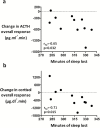Effects of Insufficient Sleep on Pituitary-Adrenocortical Response to CRH Stimulation in Healthy Men
- PMID: 28444400
- PMCID: PMC6075556
- DOI: 10.1093/sleep/zsx064
Effects of Insufficient Sleep on Pituitary-Adrenocortical Response to CRH Stimulation in Healthy Men
Abstract
Study objectives: Severe sleep restriction results in elevated evening cortisol levels. We examined whether this relative hypercortisolism is associated with alterations in the pituitary-adrenocortical response to evening corticotropin-releasing hormone (CRH) stimulation.
Methods: Eleven subjects participated in 2 sessions (2 nights of 10 hours vs. 4 hours in bed) in randomized order. Sleep was polygraphically recorded. After the second night of each session, blood was sampled at 20-minute intervals from 09:00 to 24:00 for adrenocorticotropic hormone (ACTH) and cortisol measurements, and perceived stress was assessed hourly. Ovine CRH was injected at 18:00 (1 µg/kg body weight).
Results: Prior to CRH injection, baseline ACTH, but not cortisol, levels were elevated after sleep restriction. Relative to the well-rested condition, sleep restriction resulted in a 27% decrease in overall ACTH response to CRH (estimated by the incremental area under the curve from 18:00 to 24:00; p = .002) while the cortisol response was decreased by 21% (p = .083). Further, the magnitude of these decreases was correlated with the individual amount of sleep loss (ACTH: rSp = -0.65, p = .032; cortisol: rSp = -0.71, p = .015). The acute post-CRH increment of cortisol was reduced (p = .002) without changes in ACTH reactivity, suggesting decreased adrenal sensitivity. The rate of decline from peak post-injection levels was reduced for cortisol (p = .032), but not for ACTH. Scores of perceived stress were unaffected by CRH injection and were low and similar under both sleep conditions.
Conclusions: Sleep restriction is associated with a reduction of the overall ACTH and cortisol responses to evening CRH stimulation, and a reduced reactivity and slower recovery of the cortisol response.
Keywords: ACTH; CRH; HPA axis; cortisol; sleep; stress..
© Sleep Research Society 2017. Published by Oxford University Press on behalf of the Sleep Research Society. All rights reserved. For permissions, please e-mail journals.permissions@oup.com.
Figures





References
-
- Hirshkowitz M, Whiton K, Albert SM, et al. National Sleep Foundation’s sleep time duration recommendations: methodology and results summary. Sleep Health. 2015; 1: 40–43. - PubMed
-
- Centers for Disease Control and Prevention. Percentage of Adults Who Reported an Average of <6 Hours of Sleep per 24-Hour Period, by Sex and Age Group --- United States, 1985 and 2004. Morb Mort Wkly Rep (MMWR). 2005; 54 (37): 933. http://www.cdc.gov/mmwr/preview/mmwrhtml/mm5437a7.htm. Accessed May 3, 2017.
-
- Institut National du Sommeil et de la Vigilance. Enquête INSV / MGEN NutriNet - Santé “Sommeil et Nutrition. 2015. http://www.institut-sommeil-vigilance.org/wp-content/uploads/2015/03/RES.... Accessed May 3, 2017.
-
- The Sleep Council. The Great British Bedtime Report. 2013. http://www.sleepcouncil.org.uk/wp-content/uploads/2013/02/The-Great-Brit.... Accessed May 3, 2017.
Publication types
MeSH terms
Substances
Grants and funding
LinkOut - more resources
Full Text Sources
Other Literature Sources

